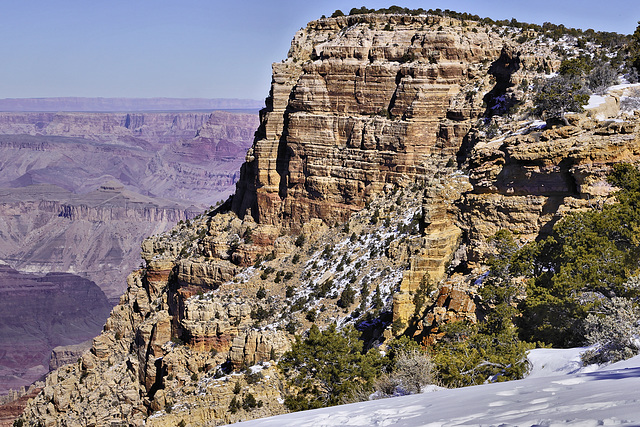Jonathan Cohen's photos
A Long Way Down – Lipan Point, Grand Canyon, Arizona
The Exercise of the Point – Lipan Point, Grand Canyon, Arizona
Over the Edge – Lipan Point, Grand Canyon, Arizona
The First View – Lipan Point, Grand Canyon, Arizona
"Hairalinas" – Sedona, Arizona
A peccary is a medium-sized animal, with a strong resemblance to a pig. Like a pig, it has a snout ending in a cartilaginous disc, and eyes that are small relative to its head. Also like a pig, it uses only the middle two digits for walking, although, unlike pigs, the other toes may be altogether absent. Its stomach is not ruminating, although it has three chambers, and is more complex than those of pigs.
Peccaries are omnivores, and will eat insects, grubs, and occasionally small animals, although their preferred foods consist of roots, grasses, seeds, fruit, and cacti – particularly prickly pear. Pigs and peccaries can be differentiated by the shape of the canine tooth, or tusk. In European pigs, the tusk is long and curves around on itself, whereas in peccaries, the tusk is short and straight. The jaws and tusks of peccaries are adapted for crushing hard seeds and slicing into plant roots, and they also use their tusks for defending against predators. By rubbing the tusks together, they can make a chattering noise that warns potential predators not to get too close. In recent years in northwestern Bolivia near Madidi National Park, large groups of peccaries have been reported to have seriously injured or killed people.
Peccaries are social animals, and often form herds. Over 100 individuals have been recorded for a single herd of white-lipped peccaries, but collared and Chacoan peccaries usually form smaller groups. Such social behavior seems to have been the situation in extinct peccaries, as well. The recently discovered giant peccary (Pecari maximus) of Brazil appears to be less social, primarily living in pairs. Peccaries rely on their social structure to defend territory, protect against predators, regulate temperature, and interact socially.
Peccaries have scent glands below each eye and another on their backs, though these are believed to be rudimentary in P. maximus. They use the scent to mark herd territories, which range from 75 to 700 acres (2.8 km2). They also mark other herd members with these scent glands by rubbing one against another. The pungent odor allows peccaries to recognize other members of their herd, despite their myopic vision. The odor is strong enough to be picked up by humans, which earns the peccary the nickname of "skunk pig".
These specimens, created for the "Javelinas on Parade" project in Sedona by sculptor Liam Herbert, are located in front of the office of Pink Jeep Tours.
Just After Sunset – Airport Mesa, Sedona, Arizona
Just Before Sunset – Airport Mesa, Sedona, Arizona
The Back of the Butte – Courthouse Butte Trail, Sedona, Arizona
Rock Chimneys – Courthouse Butte Trail, Sedona, Arizona
Jump to top
- ipernity © 2007-2025
- Help & Contact
|
Club news
|
About ipernity
|
History |
ipernity Club & Prices |
Guide of good conduct
Donate | Group guidelines | Privacy policy | Terms of use | Statutes | In memoria -
Facebook
Twitter










